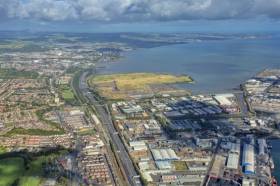Displaying items by tag: Belfast Lough
#BelfastLough - Giant's Park on the North Foreshore of Belfast Lough is set to be the location of a new film studio, according to BBC News.
The circa £14 million development aims to capitalise on Northern Ireland's increasing popularity as a filming location for hit TV series like Game of Thrones and films such as the Brad Pitt-produced The Lost City of Z.
Belfast City Council heard that hundreds of jobs could be created in the construction and operation of the studio, earmarked for the former landfill waterfront site.
In other news, a 19th-century chapel overlooking Giant's Park with stunning views over Belfast Lough is on the market as part of a 'unique' residential development.
Built by the third Marquis of Donegall in the mid-1800s, the former Chapel of the Resurrection was extensively renovated in the 1980s and is now part of a package of zoned housing lands in a very desirable part of North Belfast, as the Belfast Telegraph reports.
Historic Belfast Lough Boatyard Lives On Through Classic Yachts
The recreational marine industry is a demanding trade. Your customers buy boats for pleasure, so they assume it’s a fun business to work in. Thus there’s no lack of potential boat designers and builders to be found among the children of those who only sail for sport and fun, for they see that the adults enjoy being around boats, and they get to think that being around boats all the time for work and play is the only way to live.
But in the end, business is business. The bottom line rules everything else. However enthusiastic young people may have been when first going into the boat trade, as they battle on with running their own marine business they find the world of commerce can become a cruel place. W M Nixon considers the challenges of boat-building, and looks at the story of John Hilditch of Carrickfergus, who was one of the brightest stars of the Irish boat-building industry in the golden age of yachting, yet his light was extinguished after barely two decades.
The name of Hilditch of Carrickfergus is synonymous with classic yachts of significant age. John Hilditch built the 36ft G L Watson-designed cutter Peggy Bawn in 1894, and she still sails. In fact, she sails in better shape than ever, as she had a meticulous restoration completed for Hal Sisk of Dun Laoghaire in 2005.
More recently, in 2013 the Hilditch-built Mylne-designed Belfast Lough Island Class 39ft yawl Trasnagh was restored for Ian Terblanche in Devon in time for her Centenary. And in 2015, the Belfast Lough OD Class I Tern – 37.5ft LOA to a William Fife design and built in 1897 with seven sister-ships by John Hilditch - has appeared in Mallorca so superbly restored that when she went on to Les Voiles de St Tropez at the end of September, she won her class despite it being heavy weather, and she only just out of the box.
 Peggy Bawn in her first season afloat in 1894. She was built for A J A Lepper, Commodore of Carrickfergus Sailing Club, who was one of John Hilditch’s most loyal clients. Photo courtesy RUYC
Peggy Bawn in her first season afloat in 1894. She was built for A J A Lepper, Commodore of Carrickfergus Sailing Club, who was one of John Hilditch’s most loyal clients. Photo courtesy RUYC
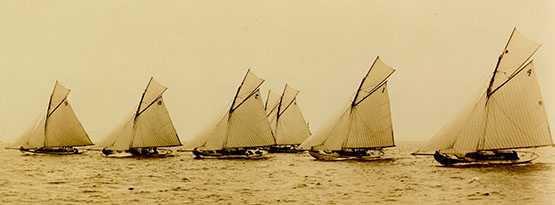
A monumental achievement. All the boats of the new Fife-designed Belfast Lough OD Class 1 of 1897 were built by John Hilditch in less than a year. Photo: Courtesy RUYC
But we don’t have to go to distant restoration specialists to find evidence of the large and varied Hilditch output. The first five boats of the Howth 17 OD class were built by John Hilditch immediately after he’d built the eight Belfast Lough Class I boats. The little new Howth gaff sloops – rigged with huge jackyard topsails as they still are today - sailed the 90 miles home down the Irish Sea to Howth in April 1898, and had their first race on May 4th 1898. All five of the original Hilditch creations continue to race with the thriving Howth 17 class, which today has eighteen boats.
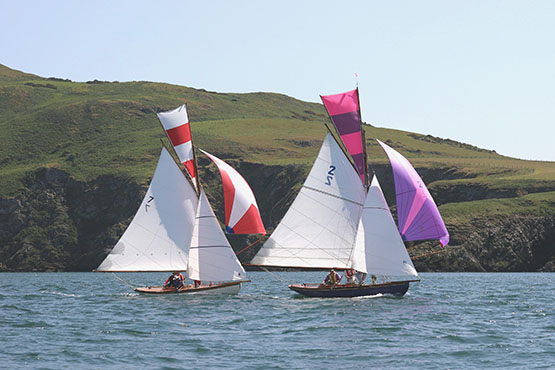
The Howth 17s Aura (left) and Pauline. Aura is one of the original five Howth 17s built for 1898 by John Hilditch immediately after he had completed the Belfast Lough Class I boats. Photo: John Deane
This concentration of yacht design development in a short time span, and through just one boatyard, is rare but not unique – the great name of Charlie Sibbick of Cowes shone equally briefly but even more brightly at much the same time, as he was a designer too. But Sibbick made his name in an established international centre for sailing. Yet when John Hilditch – who was both a seafarer and a fully-qualified shipwright – established his yard at Carrickfergus on Belfast Lough in the winter of 1892-93, the north of Ireland was still a relative backwater in international sailing terms. Thus his achievement is indeed remarkable. For by the time Hilditch closed down in the winter of 1913-14, he had put Belfast Lough firmly in the global picture as a pace-setter in yacht development, and his pivotal role in that transformation is gaining increasing recognition.
Not that there hadn’t been sailing in Belfast Lough before Hilditch came along. There are many yacht and sailing clubs around this fine stretch of sailing water, and the most senior of them is Holywood Yacht Club (on the waterfront below the hills where Rory McIlroy learned to pay golf), which dates back to 1862. And in 1866, two more new clubs came into being – Carrickfergus Sailing Club which was obviously location-specific, and the Ulster Yacht Cub, which became the Royal Ulster Yacht Club in 1869, but was a premises-free moveable feast until 1898, when America’s Cup challenger Thomas Lipton insisted it have a clubhouse, which was duly opened on an eminence close above the Bangor waterfront in April 1899.
The shared foundation year which goes back through the mists of time to 1866 means that both clubs will be celebrating their 150th Anniversaries in 2016. They’ve been quietly working on their separate plans towards celebrating this significant date, with a massive new history of the RUYC under way for a couple of years now and due for publication in the Spring, while Carrickfergus also has plans in the publication line.
Yet although there is much to write about now, in both club’s cases the pace of development was relatively slow until the late 1880s, for until that time, the business of the rapidly expanding city of Belfast was business, and more business. It wasn’t until the 1880s that leisure sailing began to get serious attention from the rapidly growing middle classes of the greater Belfast area. But once they did begin to take it up, they did so with complete enthusiasm, and the sailing pace of Belfast Lough during the 1890s, and on towards 1910, had few rivals.
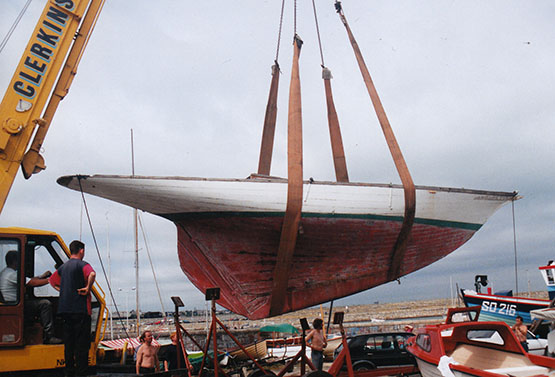
For the rapid yacht design development seen during John Hilditch’s busy years, compare this with the next image. The old-style hull of Peggy Bawn is revealed as she is lifted out of the Coal Harbour Yard in Dun Laoghaire in 1996 for a first attempt at restoration. Later, Hal Sisk took over the project, and it was completed for him by Michael Kennedy of Dunmore East. Photo:W M Nixon
 The new style shape. Although they were built only three years after Peggy Bawn, the Fife-designed Belfast Lough Class I boats had a much more modern hull shape and were primarily racing boats, yet they were required to be well capable of sailing to Scotland and Dublin Bay, and did so
The new style shape. Although they were built only three years after Peggy Bawn, the Fife-designed Belfast Lough Class I boats had a much more modern hull shape and were primarily racing boats, yet they were required to be well capable of sailing to Scotland and Dublin Bay, and did so
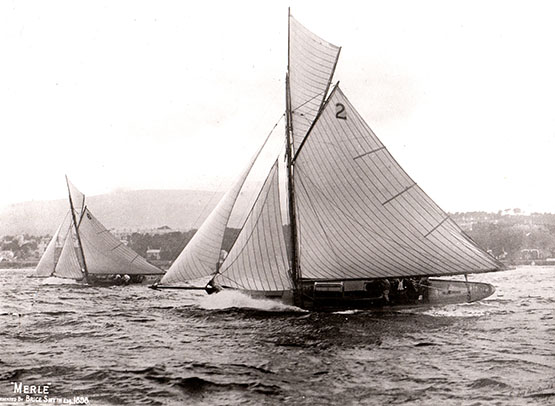 Formidable performers. The Belfast Lough Class I boats Merle (6, Brice Smyth) and Flamingo (2, John Pirrie) racing hard in 1898. Both owner-skippers were members of Carrickfergus SC, and based their boats there. Photo: Courtesy RNIYC
Formidable performers. The Belfast Lough Class I boats Merle (6, Brice Smyth) and Flamingo (2, John Pirrie) racing hard in 1898. Both owner-skippers were members of Carrickfergus SC, and based their boats there. Photo: Courtesy RNIYC
In order to meet this demand, John Hilditch was able to expand his new boatyard at an extraordinary pace. Even then, he couldn’t keep up with demand, such that one new Belfast Lough class, the Linton Hope-designed lifting-keel 17ft LWL Jewel Class of 1898, had to be built in Chester in England. And at the same time, the fishing-boat builder James Kelly of Portrush on the North Coast found that yacht-building to supply the new craze was much more lucrative than producing his own variant of the classic Greencastle yawl for fishermen on both the Irish and Scottish coasts, and he went into yacht-building both for Belfast Lough and Dublin Bay.
But in terms of overall contribution to the transformation of Belfast Lough sailing, John Hilditch was very much in a league of his own. So much so, in fact, that noted international classic sailing polymath Iain McAllister got to thinking last winter that even though no trace whatsoever now remains of this once famous yard, it was time and more for John Hilditch’s work to be celebrated, and how better than a Hilditch Regatta during 2016 to tie in with other Belfast Lough sailing celebrations?

It’s a great idea which seemed almost too good to be true. But thanks to quiet work behind the scenes, most notably by Wendy Grant who recently became Commodore of Carrickfergus Sailing Club neatly in time to hold the top post during the 150th celebrations (she’s the mother of renowned offshore navigator Ian Moore), plus a special sub-committee in RUYC which likewise holds to the notion that the early stages of good work are best done by stealth, a programme is emerging which will keep all organising parties happy while providing participants with a manageable user-friendly schedule.
It has all become viable during this past week thanks to the confirmation that the more distantly-located significant classic boats of the Hilditch oeuvre – Peggy Bawn of 1894, Tern of the 1897 Belfast Lough Class I, the Howth 17s of 1898, and Trasnagh, the Island Class yawl of 1913 – all hope to be in Belfast Lough towards the end of June 2016, where numbers will be further swollen by the Hilditch-built Royal North of Ireland YC Fairy Class of 1902, together with some of their sister-ships from Lough Erne.
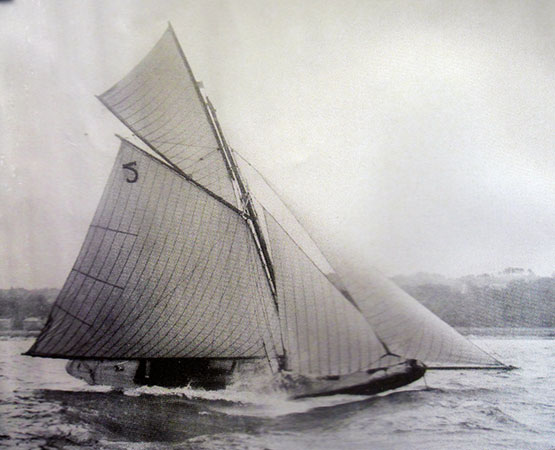
The Hilditch-built Tern in a breeze of wind on Belfast Lough, 1898
Tern in a breeze of wind at St Tropez, September 2015.
In addition, the fleet will be increased by other classics of every type, coming together to wish the Hilditch boats well at this special time. And there’ll be a goodly contingent of Irish Sea Old Gaffers which will be heading towards the big event on Belfast Lough in late June by way of the Old Gaffers Rally at Portaferry in the entrance to Strangford Lough from June 17th to 19th.
But before getting carried away by anticipation of all this festivity, let us remember that this week’s thoughts were introduced by a precautionary reminder that the boat-building trade is no bed of roses. So just what did go wrong, that the much-admired Hilditch yard faced closure before the end of 1913, with the man himself dead – perhaps broken-hearted – before the end of 1914?
There seem to be a number of explanations, all of which combine to explain the sudden demise of a great enterprise. The incredible rate of economic expansion in Belfast – which had been accelerating virtually every year since around 1850 – seems to have first shown significant signs of slackening in 1910. The greater Belfast economy did continue to expand in the broadest sense, but the rate of expansion was now slowing.
During the rapid growth years, John Hilditch was able to meet demand, but regardless of the underlying economic patterns, by 1910 his market was beginning to reach saturation levels. If people had continued to change their boats every three years or so – as they’d anticipated doing when the Belfast Lough One Design Association was established in 1896 – then an artificial demand might have been maintained. But people were beginning to realise that a good one design boat was good for much longer than a mere three years. In fact, some argued that a class was only bedded in after three years. So the number of new boats being ordered dried to a trickle.
Yet those boats that were being ordered became individually larger. When the Alfred Mylne-designed 39ft Belfast Lough Island Class yawls began to be conceptualised as the world’s first true cruiser-racer one designs in 1910, they would be far and away the biggest and most expensive one designs Hilditch had yet built. He held out for a price of £350 per boat, but the potential owners – hard-headed Belfast businessmen determined to drive a tough bargain and not to be seen to weaken – wouldn’t budge beyond £345.
In those days, yacht-building was simply priced by overall length, so Hilditch resigned himself to accepting the £345 by agreeing to build a boat with a slightly shorter bow. For all parties, it was a case of cutting off one’s nose off to spite one’s face. The new Island Class yawls were handsome enough. But with a longer bow, they’d have been beautiful.
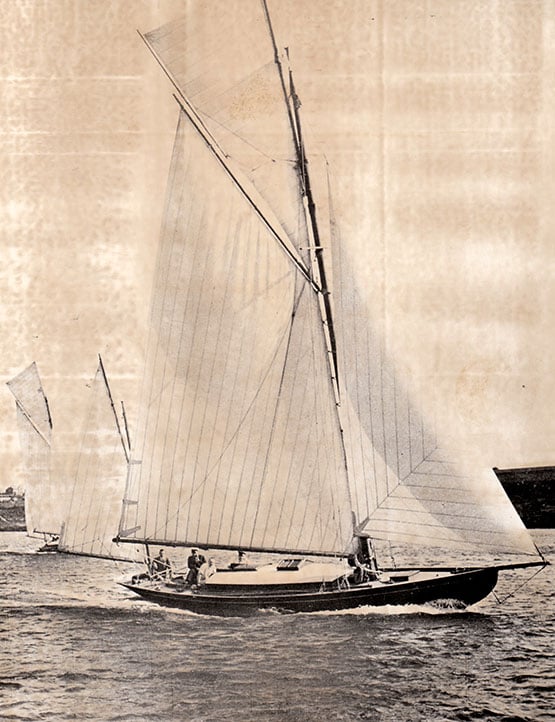 The island Class yawl Trasnagh, seen here in her first season of 1913, is believed to be the last boat to have been built by John Hilditch. Photo: Courtesy RNIYC
The island Class yawl Trasnagh, seen here in her first season of 1913, is believed to be the last boat to have been built by John Hilditch. Photo: Courtesy RNIYC
The last of them, Trasnagh herself in 1913, was the last boat to come out of a formerly great yard rapidly tumbling towards extinction. The times were restless politically as well as economically, so it wasn’t a good time to rely on building pleasure boat for a living. And apart from the saturation of the market and the financial demands of building the relatively large Island Class boats, sailing was no longer attracting the same number of newcomers, as rival interests such as motor cars and aeroplanes were taking away many potential enthusiasts,
Yet ironically, had John Hilditch been able to hang on for just another year into the beginning of the Great War of 1914-18, a slew of war work for the Admiralty would have given his yard a new lease of life. But it was not to be. The yard was gone. And soon, so too was the man himself.
But the boats live on. One hundred and two years after John Hilditch’s death, boats that he created are still sailing the seas, and their assembly in Belfast Lough from June 22nd 2016 onwards will be a reminder that, once upon a time, on a site long since covered by Carrickfergus’s re-developed waterfront, John Hilditch and his team built nearly a hundred fine yachts, the best of which have well stood the test of time. All that together with the 150th Anniversaries of two remarkable sailing clubs. For sure, late June on Belfast Lough is going to be one very special time.
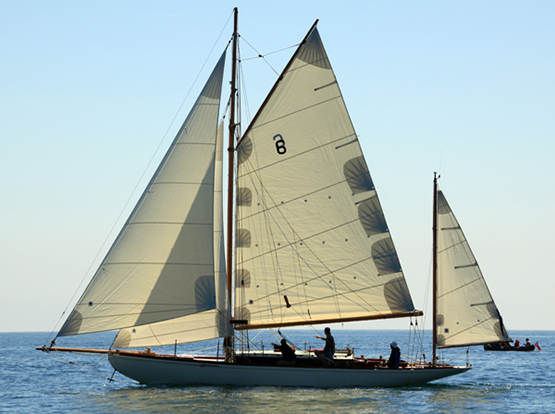
Trasnagh restored for her Centenary in 2013
Green Business Hub For Belfast Lough Foreshore
#BelfastLough - Belfast Lough's north foreshore will soon be home to a concentration of sustainable businesses that promises to be a first for Northern Ireland.
UTV News reports on the Cleantech Hub, a 30-acre waterfront site at Giant's Park aimed at firms in the renewables, environmental and low-carbon sectors.
Already adjacent to the site is a plant that converts gas from landfill to electricity powering 2,500 homes.
And it's hoped that the new scheme "will now firmly position the city as a leading destination for green technology, enhancing the profile of the sector here, as well as generating interest beyond these shores," according to David McNellis of agents Lisney, managing the hub on behalf of Belfast City Council.
UTV News has more on the story HERE.
World’s Largest Ice-Class Breaking Tanker Docks in Belfast
#ArcticBelfast - As previously reported on Afloat’s Ferry News, this week Belfast Port had an eighth Stena vessel docked in the harbour which today marks 20 years of ferry operations, writes Jehan Ashmore.
Easily the largest ship is Stena Arctica (belonging to the Stena Group), which is a 117,000 dwt crude oil tanker from an ice-breaker series. The large oil products tanker fitted with an ice-breaking bow is undergoing a major refit for Stena Bulk at Harland & Wolff.
The UK flagged vessel of 249.79m in length on a beam of 44.07m and a draft of 6m is occupying H&W's Belfast Dry-Dock. Stena Arctica is the world’s largest oil tanker that is with an ice class 1A super certification. The design of the vessel allows the tanker to cope in navigating extreme ice conditions with up to 1 metre thick ice.
She is longer and wider than a conventional ice-tanker. Also, the ‘Arctica’ has more built-in steel in her sturdy ice belt, extra-strengthened frames, and an ice-propeller that is more robust than normal.
In a harsh and frozen environment, the ‘Arctica’s’ main engine provides more than 50% of her power. The bridge has a 360-degree view for greater safety in narrow waters. She is optimally designed for safe carriage of oil in the Baltic Sea all year round.
As for the other seven Stena ships in Belfast Port referred above, they are from their Irish Sea North ferry fleet serving out of the harbour. All of the fleet underwent a £6m refit investment programme also at H&W that was completed in Easter. The bulk of the upgrade on these ferries including freight vessels was carried out at the yard over a five month timeframe.
Among those upgraded in the refit programme was the ‘Heysham-max’ class freight-ferry Stena Precision. She belongs to a quartet as route-mate Stena Performance also sails on the Belfast-Heysham service which carries mostly freight and leisure traffic.
The other pair that makeup the ro-ro class quartet remain running for Seatruck Ferries on their Dublin-Liverpool service which is to expand with a third ship next week.
Belfast Lough Sailability Names Three New Boats
#Sailability - Belfast Lough Sailability has added three new boats to its fleet, as the Carrick Times reports.
The 2.4 Olympic class boats Peg and Skye and the Hawk 20’ day sailor keel boat Arica were officially named in a ceremony at Carrickfergus Marina recently.
And all three were made available for sailing to those with disabilities in the Mid and East Antrim Borough and the wider Northern Irish community.
Events that the initiative supports include this summer's Sailability Round Ireland cruise, which saw the donation of a Squip dinghy to the recently established Foyle Sailability for the north-west border region.
The Carrick Times has more on the story HERE.
Newcomer As ASD Tug Enters Service in Belfast Port
#NewBelfastTug – One of the largest UK independent harbour tug firms, SMS Towage has taken delivery of another tug for its Belfast operations last month.
The new ASD (azimuth stern drive) tug to Belfast brings the overall investment in the Northern Irish city port to over £9m having began operations just over two years ago in October 2013.
The Turkish-built ASD Merchantman completed in 2009 has a 50 bollard tonnes. The near 25m long vessel is sister to the ASD Masterman (as previously reported on Afloat.ie) which entered service in the city also in 2013.
Together they form the most modern fleet of omni-directional tugs in Belfast Harbour, said joint managing director Gareth Escreet of Hessle, East Yorkshire-based SMS Towage.
“This is a significant level of investment, and shows our commitment and confidence in the growing level of activity we are experiencing in Belfast,” said Gareth.
“With an operational life here beyond 2030, it allows us to leverage the fleet advantages of commonality of spare parts, training, and vessel familiarisation.”
SMS Towage began trading in Belfast due to the attraction as desired for change from major port users and with potential for work from a new offshore wind terminal and a purpose built cruise terminal.
Last year, Belfast saw a record 112,000 cruise passengers pass through the port.
The tug firm also deals with regular vessel towage work from the Fred Olsen-owned businesses of Dolphin Drilling and Harland & Wolff.
The Olsen group includes the Fred. Olsen Cruise Lines whose ships have visited the port. The most recent example been Boudicca which was on a ‘no passport required' cruise last month of the UK and Ireland.
Dramatic Sailing for Conclusion of Belfast Lough Autumn Yachting Series
There was some dramatic sailing on the final day of the Belfast Lough Autumn Series. Whilst many of the first Class prizes in the series had already been decided, this didn't stop those behind trying their hardest to make a mark.
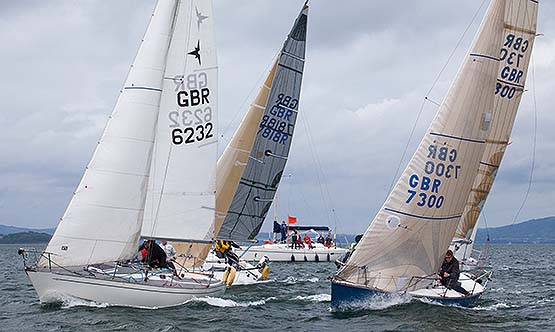
The IRC fleet got away first in a shifting southerly breeze. Whilst 15 knots and gusts of up to 25 knots were forecast, the wind eased just before the start and most started with full sail though stretched to their maximum. Both Indigo and Final Call clung to the back of Giggle as close as possible upwind. The wind backed at the end of each of the downwind legs forcing boats to drop their spinnakers and gybe at the leeward mark asking for perfect teamwork and coordination. Giggle was first to feel the pressure with some unusual spinnaker fleg flying and the halyard refusing to drop. Fifty foot of asymmetric is a bit of an anchor on the upwind leg and allowed Indigo to record their second win of the series followed by Final Call.
Ken Green has obviously been watching some of the Americas Cup manoeuvres in Bermuda and pulled a fantastic start in the Sigma fleet sailing underneath Cariad and Sqwawk to keep both high of the committee boat until just before the signal. Starshine Challenger the took advantage of some favourable lifts getting the first of any gusts and quickly built a comfortable lead. Sqwawk drew Cariad into a tacking duel and just squeezed past at the top mark though Cariad followed closely on the way back down and tried hard to drop their kite at the last minute to keep the pressure on. Unfortunately their spinnaker backed either side of their genoa making retrieval very slow and allowing Sqwawk to escape.
Mingulay and Margarita had another tight race in the CYCA class with the former getting away but being slowly dragged back by the finish to a dramatic final on elapsed time. Team Curry, Wilde and Nixey had their best race of the series, scoring second on corrected time, with Colonomas coming in fourth.
While Jonathan Star had already secured the NIRKRA prize, the series points were very close in the ranks below. The leaders built a good lead quickly followed by Alan Morrison's Starflash who had only the father/son team of John and Conor Simms to assist him but went on to score their best result of the series. They were followed closely by QtPi and Manzanita but it was David Quinn's Chatterbox just behind who scored the race win on handicap and with it, second place in the series.
The Belfast Lough Autumn Series has seen some of the best keelboat racing of the year with differing but manageable conditions throughout, unseasonable warm temperatures and great courses laid on by Race Officer Colin Loughead and his committee boat and mark laying team. All of the crews attended the overall prize giving at Ballyholme Yacht Club where BYC Commodore Mark Mackey and RUYC Vice Commodore Myles Lindsay gave many thanks to them and the Committee boat owners, in particular Elaine and David Taylor who stood in for all of the October races.
Overall Results
IRC
1. Giggle Phil Davis
2. Final Call J Minnis/ B Roche
Sigma
1. Sqwawk Paul Prentice
2. Starshine Challenger Burton Allen
CYCA
1. Mingulay. John & Mandy Ritchie
2. Margarita. John Moorehead
NIRKRA
1. Jonathan Star Garth, Kathryn and Myles Lindsay
2. Chatterbox. David Quinn
Waverley
1. Montrose Robin & Victoria Millar
2. Ivanhoe John McCrea
Cargo Giant Docks In Belfast For Emergency Repairs
#Shipping - A gigantic cargo ship nearly a third of a kilometre long has docked in Belfast for emergency repairs.
As the Belfast Telegraph reports, the Al Oraiq is the largest shipping vessel Belfast Lough has seen in almost three decades, only beaten in terms of sheer size by next-generation cruise liners like the Royal Princess, which visited the city just over a year ago.
The 300-plus-metre giant is expected to be docked in Harland & Wolff for a number of weeks of surveys and repairs. The Telegraph has more on the story HERE.
McGovern Makes Waves at Ballyholme Icebreaker
Sunday afternoon saw the second race of the Lisglass Builders Icebreakers Series with a wide range of dinghies across all classes.
The Topper class is still depleted with squad training going on elsewhere but it was good to see Freya Sharp out for her first race in one of the BYC Eric Twiname boats, and 3 Fevas on the water with the brother-sister crew of Jamie and Ellie Mackey battling around the race course. Memories were evoked from 35 years ago of the Flannigan brothers - similarly competitive in their Cadet dinghy. Ollie Haig scored his second win of the series in the Topper while Catherine Pooler and Anna Wilson from SLYC similarly won the Low PY class.
In the larger PY class, Gareth Flannigan and Dave Fletcher stormed away from his brother Robin with Diane Burgess in the RS400s, and the rest of the following RS200s, Laser 2000s and Sandra Halliwell going it alone this week in her new RS Aero 5. Hopefully Susanna will be not be forgotten.
The Multihull fleet saw a new F18 entrant in the guise of Andrew Gallagher and his novice crew "Gordon" Ritson. Great to see Aaron being dragged into the family sport. The F18 fleet all started on port against Stephen Magee alone in his Dart 18 with the well poslished crew of Adrian Allen and Barry Swanston getting up to speed first and building up a big lead by the finish.
Russell McGovern has been a welcome addition to the Laser Icebreaker fleet this year, having not sailed in the dinghy since his Australian days and now many years after his Olympic campaign before joining his brother Matt in the 49er. In recent times, he has been very successful imparting his knowledge to the ISA Radial squad including Ballyholme's Liam Glynn who won a Europa Cup event last summer.
A southerly breeze encouraged many of the Laser fleet to go for the pin-end of the line with those able to tack and get away quickly up the shore to the South east mark making the gains. Russell showed his speed rounding the first mark in the lead from Mark Mackey closely followed by Richard Ramsey and Garth Maxwell. Chris Boyd sailed down on the outside of the first downwind to chase Russell with Robin Moran close on his heels. The usual carnage and hailing could be heard behind.
A great race ensued with places changing rapidly and then rewon. With Russell now covering, Chris Boyd closed within striking distance at the end. Richard Ramsey nipped in front of Robin Moran for third place, with Robin also losing out to Phil Anderson who took the shorter route to the finish line. It will be the last time Mark Mackey tells Phil which way to go, finishing 6th behind the two of them.
In the Laser Radial fleet, Tom Purdon showed some great speed although learnt a few lessons in which Lasers to cross and which not to mess with. Liam Glynn won with Brian Bibby coming second ahead of Tom. In the Laser 4.7 fleet, new RYANI squad member Sam Rutherford scored his first win.
Next week sees Race 3 but there may be issues with Irelands triumphant win over France meaning a Sunday start against Argentina at 1300. Stay tuned to Ballyholme's Facebook page for any changes.
Full results here
Everything to Play for at Belfast Lough Autumn Series
A bit more breeze on Sunday morning on Belfast Lough encouraged Autumn Series Race Officer Aidan Pounder to give the fleets a longer course than has been experienced in the previous lighter weekends. Racing got away promptly and immediately there were questions as to where was best to go – the expected lift on the right hand side but potential "holes" closer to shore, or the steadier breeze on the left with a nasty chop over most of the course to contend with.
Despite the obstacle course, there was tight across all fleets if not always at the front. Giggle escaped in the larger IRC fleet but behind Final Call had their best race of the series staying close enough to Indigo to beat them by just 12 seconds on corrected time.
In the Sigma fleet, Cariad had their best race for a number of weeks with the combined brains of owner Gerry Bell and Rob Armstrong setting the tactics. Taking advantage of the left hand breeze they got an advantage by the first mark which they managed to hold onto until the finish. Behind them Sqwawk and Starshine Challenger traded places continually, kept closer by some unusual spinnaker hoists aboard the former. At the final bottom mark the boats were still so close that the race places will be determined in the protest room at a later date. It was great to see Burton Allen aboard Startshie Challenger as competitive as ever goading on his returning helm Ken Green.
In the CYCA handicap, John Moorehead enjoyed his first win of the series aboard Margarita winning by just 11 sesconds from Mingulay.
The NIRKRA fleet saw some of the tightest racing with the lead changing places several times between Starflash, Manzanita and Jonathan Star. Only Mumbo Jumbo got left behind with a poor spinnaker hoist on the final leg. On the last lap, Jonathan Star managed to escape from the rest and scored their second win of the series. Manzanita followed with QtPi scoring third by 5 seconds from Starflash.
With two races left in the series, only Giggle can feel safe in the IRC fleet with everything to play for across the other classes.
Full results here




























